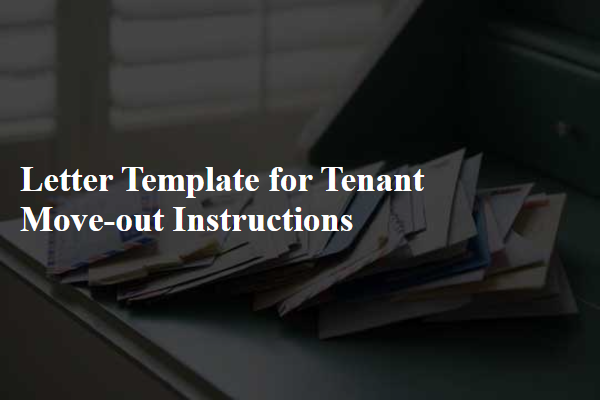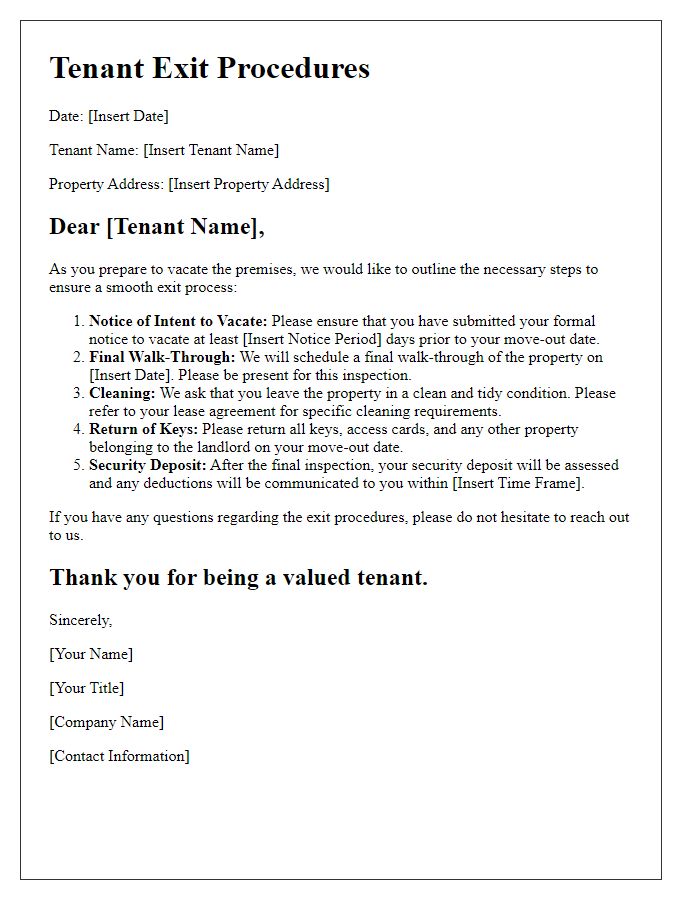Moving out can be both an exciting and overwhelming experience, and having clear instructions can make all the difference. Whether you're saying goodbye to your cozy apartment or transitioning to a new house, it's essential to ensure everything goes smoothly as you prepare for the next chapter. In this article, we'll provide you with a comprehensive letter template that outlines tenant move-out instructions, making the process easier and less stressful. So, let's dive in and explore how to make your move-out a breeze!

Property cleanliness and condition guidelines
When moving out of a rental property, tenants must adhere to specific cleanliness and condition guidelines to ensure the return of their security deposit. Kitchens, including appliances such as stoves and refrigerators, should be thoroughly cleaned, with all food remnants removed and surfaces wiped down. Bathrooms, featuring fixtures like sinks and tubs, must be scrubbed to eliminate soap scum or mildew. Living areas, particularly carpets and flooring, should be vacuumed or mopped to remove dust and debris. Additionally, windows and screens must be cleaned to allow natural light to enter the space effectively. Walls should be free from marks or damages, and any personal belongings must be removed prior to the final inspection. Failure to meet these standards may result in deductions from the security deposit for cleaning or repairs.
Security deposit return procedures
When tenants move out of a rental property, understanding the security deposit return procedures is essential for a smooth transition. Tenants must provide a written notice, typically 30 days in advance, specifying their intended move-out date. The property inspection, conducted by landlords or property managers, evaluates the condition of the apartment, identifying any damages beyond normal wear and tear. This inspection is crucial to determine the amount to be deducted from the security deposit. Security deposits, often amounting to one month's rent, are usually returned within a state-mandated timeframe, which can range from 14 to 30 days post-move-out. Tenants should ensure a forwarding address is provided to facilitate the return process. Documentation, such as receipts for repairs or cleaning services, may be required for deductions. Familiarity with state laws, like those in California or New York, is vital as they dictate security deposit handling and tenant protections.
Utility cancellation or transfer instructions
Moving out of a rental property involves several important steps, particularly regarding the management of utilities. Tenants should ensure they contact local utility providers to initiate the cancellation or transfer of services such as electricity, water, gas, and internet. This process should ideally begin at least two weeks prior to the move-out date to ensure a smooth transition. For example, if a tenant is moving out of an apartment in New York City, they must notify Con Edison for electricity (account number required) and the New York City Department of Environmental Protection for water services. In addition, for internet services, contacting providers like Comcast or Verizon for disconnection or transfer is essential. Properly documenting the final meter readings can prevent discrepancies and ensure accuracy in billing. These steps help avoid unnecessary charges and guarantees that the tenant has complied with the move-out requirements set by the lease agreement.
Key and access device return process
When transitioning out of a rental unit, tenants must follow the key and access device return process to ensure a smooth departure. Ensure all property keys, such as front door keys, mailbox keys, and any common area keys, are collected and ready for return. Access devices, including garage remotes or keypad entry codes, should also be compiled. Schedule a coordinated time to return these items to the property manager or landlord, preferably before the lease termination date specified in the rental agreement. Document this return process, noting the date and time, and receive a receipt for all returned items to maintain a clear record. Both parties should confirm condition and completeness to avoid disputes regarding security deposits.
Forwarding address for correspondence and deposit
When tenants prepare to vacate rental properties, providing a forwarding address for future correspondence and security deposit returns is essential. This process ensures that landlords can communicate important information about final utility bills, repair deductions, and the status of the security deposit. Tenants should include an accurate forwarding address where they can be reached after moving out, ensuring timely receipt of any necessary documentation or funds. Additionally, specifying a primary contact method, such as an email address or phone number, can facilitate smoother communication during the transition phase. Properly documented move-out procedures can significantly enhance the overall experience for both tenants and landlords, reinforcing mutual respect and clarity.













Comments